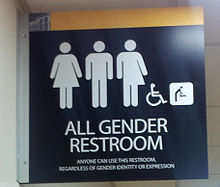User:JustinePorto/Public toilets in Minnesota
| Public toilets in Minnesota | |
|---|---|
 Latrine building built by the Works Progress Administration in 1939 in Minneopa State Park. | |
| Language of toilets | |
| Local words | washroom |
| Men's toilets | Men |
| Women's toilets | Women |
| Public toilet statistics | |
| Toilets per 100,000 people | 24 (2021) |
| Total toilets | ?? |
| Public toilet use | |
| Type | Western style sit toilet |
| Locations | hotels theaters train stations department stores |
| Average cost | ??? |
| Often equipped with | toilet paper |
| Percent accessible | ??? |
| Date first modern public toilets | ??? |
| . | |
Public toilets in Minnesota, commonly called washrooms, are found at a rate of 24 per 100,000 people. The lack of public toilets along Interstate 90 caused problems for long haul truckers.
Public toilets[edit]

A lot of tenement housing in the early 1900s lacks toilet provisions.[1]
A 2021 study found there were 24 public toilets per 100,000 people.[2] Minneapolis–Saint Paul had 24.10 public toilets in public parks per 100,000 residents in 2018.[3]
The public toilets at Varsity Theater in Minneapolis were Cintas' 2013 America's Best Restroom winner.[4]
History[edit]
Minneapolis was one of the biggest cities by population in the United States in 1900.[5] The Progressive Era saw reformists make a major push to address public hygiene. As part of this push, they sought to improve the toilet and sanitation in tenement housing in cities across the United States.[1]
As the Prohibition effort began to take more shape in the 1910s, large cities in the Northeast and Midwest had women's groups advocating for the creation of large numbers of comfort stations as a way of discouraging men from entering drinking establishments in search of public toilets. This was successful in many places in getting cities to build comfort stations, but the volume of new public toilets built was rarely enough to meet public needs.[6]
Allentown, Atlanta, Detroit, Jackson, Lansing, Minneapolis, Philadelphia and San Francisco all began construction of public toilets in response to the passage of the 18th amendment and the resulting closure of public toilets in saloons.[7]
Starting in the 1920s, middle and upper-class women living in cities stopped using public toilets, and instead shifted to toilets in facilities like hotels, theaters, train stations and department stores. While these toilets were free to use, the cultural expectation was that they would be exclusively used by clients or people who had purchased tickets. This helped ensure that these facilities were not accessible to working class women.[1]
Minneapolis was one of the largest cities in the United States in 1950,[8] a time when most big cities operated public pay toilets. The fee to access these toilets was around a nickel or a dime, with the money earned being invested back into toilet maintenance and upkeep.[1] By 1980, coin-operated toilets had almost disappeared from the public landscape.[1]
The lack of public toilets along the western part of Interstate 90 during the 2000s caused problems for long haul truckers. Their solution was often to pee into bottles and then leave them along the road in bushes. Sometimes, road maintenance crews and mowers would run over them as they could not see them in the high grass, resulting in a shower of warm, stale urine.[9]
After North Carolina banned people from using public toilets that matched with their gender identity and required people use the public toilet that matched with their sex in 2016, the state considered banning travel by state employees paid paid by the state to North Carolina. [10]
References[edit]
- ^ a b c d e Yuko, Elizabeth (5 November 2021). "Where Did All the Public Bathrooms Go?". Bloomberg News. Retrieved 12 October 2022.
- ^ QS Supplies (11 October 2021). "Which Cities Have The Most and Fewest Public Toilets?". QS Supplies. Retrieved 10 October 2022.
- ^ Park, Young Shin; Bliss, Donna Z. (2018). "Availability of Public Toilets in Major International Cities Using Geographic Information Systems". Neurourology and Urodynamics.
- ^ Nast, Condé (2014-01-23). "To Sochi: These Are How Public Restrooms Should Look". Condé Nast Traveler. Retrieved 2022-10-26.
- ^ "Largest US Cities: 1900". demographia.com. Retrieved 2022-10-12.
- ^ Baldwin, P. C. (2014-12-01). "Public Privacy: Restrooms in American Cities, 1869-1932". Journal of Social History. 48 (2): 264–288. doi:10.1093/jsh/shu073. ISSN 0022-4529.
- ^ Baldwin, P. C. (2014-12-01). "Public Privacy: Restrooms in American Cities, 1869-1932". Journal of Social History. 48 (2): 264–288. doi:10.1093/jsh/shu073. ISSN 0022-4529.
- ^ "Largest US Cities: 1950". demographia.com. Retrieved 2022-10-12.
- ^ Molotch, Harvey; Noren, Laura, eds. (2020-12-31), "Rest Stop: Trucker Bomb", Toilet, New York University Press, pp. 115–116, doi:10.18574/nyu/9780814759646.003.0013, ISBN 978-0-8147-5964-6, retrieved 2022-10-23
- ^ "California approves gender-neutral bathrooms". www.cbsnews.com. Retrieved 2022-10-26.
